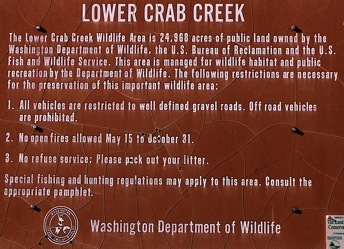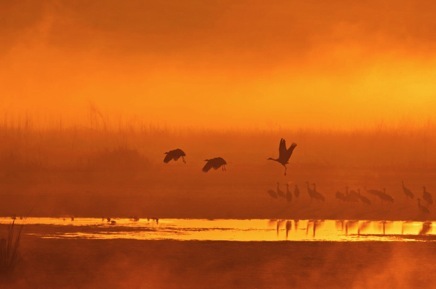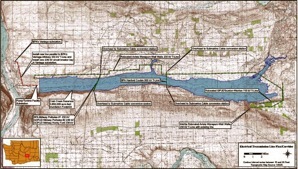






click here to view the wildlife slideshow of Crab Creek.
Of the hundreds of species that live in or migrate through Crab Creek, some of the most visible and important are Sandhill cranes. Thousands of cranes migrate through the area in spring of each year, feeding in wildlife refuge fields during the day and roosting in Crab Creek at night. The migration of cranes is celebrated each spring during the Othello Sandhill Crane Festival. An excellent guide to Sandhill spring migration is found at the Nebraska Game & Parks Commission website.
In addition to cranes, hundreds of species of birds of all kinds inhabit and migrate through the Crab Creek system. Species spotted in the area include American White Pelican, Great Egret, Golden and Bald Eagles, Swainson’s and Ferruginous Hawks, Chukar, Sandhill Crane, Short-eared, Snowy, and Burrowing Owls, Cassin’s Vireo, Sage Thrasher and Sage Sparrow. Waterfowl include Canada geese, mallards, redheads, canvasbacks, ringnecks, ruddy ducks, gadwalls, blue and greenwing teal, shovelers, pintails, goldeneyes, and wood ducks. Crab Creek is an extraordinary home to birds of all kinds.
Lower Crab Creek is an important wildlife area, comprising 19,000 acres of designated federal and state wildlife lands, including the Columbia National Wildlife Refuge. The designation and protection of Lower Crab Creek lands for wildlife is part of the mitigation package for the Columbia Basin Project, which surrounds the LCC watershed on three sides.
Converting Lower Crab Creek’s abundant and valuable wildlife habitat into a water supply reservoir would completely destroy important values of the watershed as described below. A host of agencies and organizations have recognized Lower Crab Creek’s values over the years, including U.S. Fish & Wildlife Service, Washington State Office of Tourism, Washington Department of Fish & Wildlife, Audubon Society and others. Click here for more on the Lower Crab Creek Wildlife Area.





Sandhill Cranes, Crab Creek. To see more, click here. Photo: Kathy Admire
Home | Contact Us | About Us | Join CELP | Ralph W. Johnson
Center for
Environmental Law & Policy

























